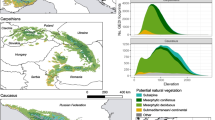Abstract
Data related to forest cover in the Cache River, Arkansas, USA were collected and analyzed to quantify changes in forest cover since 1935. Forest cover loss during the period 1935 to 1987 was characterized using data derived from aerial photography, historical map products, and Landsat satellite multispectral imagery. Forest cover in the basin declined from 65% to 15% over the 52-year period (a loss of 108,000 ha of forest cover). There was little change in forest cover between 1975 and 1987. Remaining forest stands in the basin are fragmented and small in size. Comparing forest-stand data with Soil Conservation Service data revealed that 90% of the forest loss in the southern half of the basin occurred in hydric soil areas, thus indicating a significant loss of forested wetlands.
Similar content being viewed by others
Literature cited
Abernethy, Y. and R.E. Turner. 1987. US forested wetlands 1940–1980. Bioscience 37:721–727.
Baker, J.A. and K.J. Killgore. 1994. Use of Flooded Bottomland Hardwood Wetland by Fishes in the Cache River System, Arkansas. US Army Corps of Engineers Waterways Experiment Station, Vicksburg, MS, USA. Technical Report WRP-CP-3.
Clairain, E.J., Jr. and B.A. Kleiss. 1989. Functions and values of bottomland hardwood forests along the Cache River, Arkansas: implications for management. USDA Forest Service Southeastern Forest Experiment Station General Technical Report SE-50. Ashville, NC, USA.
Cubbage, F.W., and C.H. Flather. 1993. Forested wetland area and distribution—a detailed look at the south. Journal of Forestry 91, 5:35–40.
Dahl, T.E. 1990. Wetland losses in the United States, 1780’s to 1980’s. U.S. Department of the Interior, Fish and Wildlife Service, Washington, DC, USA.
ERDAS. 1994. ERDAS Field Guide, 3rd ed. ERDAS, Inc., Atlanta, GA, USA.
Gosselink, J.G. and L.C. Lee. 1989. Cumulative impact assessment in bottomland hardwood forests. Wetlands 9:89–174.
Hupp, C.R. and E.E. Morris. 1990. A dendrogeomorphic approach to measurement of sedimentation in a forested wetland, Black Swamp, Arkansas. Wetlands 10:107–124.
Kleiss, B.A. 1994. Sediment retention in a bottomland hardwood wetland in eastern Arkansas. Wetlands 16:321–333.
Klimas, L.V. 1988. Forest vegetation of the leveed floodplain of the lower Mississippi River. Lower Mississippi River Environmental Program Report II. Mississippi River Commission. Vicksburg, MS, USA.
Kress, M.R. and S. Bourne. 1995. Cache River Basin, Arkansas: Environmental database, compact disk data archive, and metadata documentation. U.S. Army Engineer Waterways Experiment Station, Vicksburg, MS. USA. Technical Report WRP-SM-13.
Mauncy, M. and G.L. Harp. 1979. The effects of channelization on fish populations of the Cache River and Bayou DeView. Arkansas Academy of Sciences Proceedings 33:51–54.
Mitsch, P.P. and Gosselink, J.G. 1993. Wetlands, 2nd edition. Van Nostrand Reinhold, New York, NY, USA.
Nestler, J.M. and K.S. Long. 1994. Cumulative impact analysis of wetlands using hydrologic indices. U.S. Army Engineer Waterways Experiment Station, Vicksburg, MS, USA. Technical Report WRP-SM-3.
Swain, P.H. and S.M. Davis. 1978. Remote Sensing: The Quantitative Approach. McGraw-Hill Book Company, New York, NY, USA.
Turner, R.E., S.W. Forsythe, and N.J. Craig. 1981. Bottomland hardwood forest land resources of the southeastern United States. p. 13–28. In J. R. Clark and J. Benforado (eds.) Wetlands of the Bottomland Hardwood Forests. Elsevier, Amsterdam, The Netherlands.
USDA Soil Conservation Service, 1968. Soil survey of Woodruff County Arkansas. Washington, DC, USA.
USDA Soil Conservation Service. 1974. Soil survey of Jackson County Arkansas. Washington, DC, USA.
USDA Soil Conservation Service. 1977. Soil survey of Poinsett County Arkansas. Washington, DC, USA.
USDA Soil Conservation Service. 1978. Soil survey of Lawrence County Arkansas. Washington, DC, USA.
USDA Soil Conservation Service. 1979. Soil survey of Craighead County Arkansas. Washington, DC, USA.
USDA Soil Conservation Service. 1991. Hydric soils of the United States. Washington, DC, USA. Miscellaneous Publication No. 1491.
Wakeley, J. S. and T. H. Roberts. 1994. Avian distribution patterns across the Cache River floodplain, Arkansas. U.S. Army Engineer Waterways Experiment Station. Vicksburg, MS, USA. Technical Report WRP-CP-5.
Author information
Authors and Affiliations
Rights and permissions
About this article
Cite this article
Kress, M.R., Graves, M.R. & Bourne, S.G. Loss of bottomland hardwood forests and forested wetlands in the Cache River Basin, Arkansas. Wetlands 16, 258–263 (1996). https://doi.org/10.1007/BF03161317
Received:
Revised:
Accepted:
Issue Date:
DOI: https://doi.org/10.1007/BF03161317




